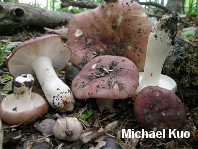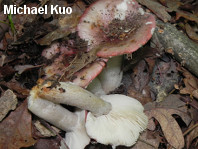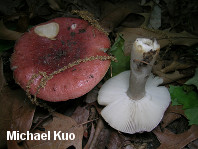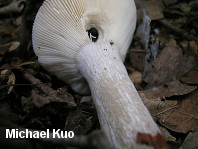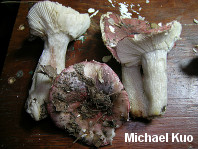Russula vinacea (MushroomExpert.Com) (original) (raw)
Russula vinacea
[ Basidiomycota > Russulales > Russulaceae > Russula . . . ]
by Michael Kuo
In the Midwest this species is common, distinct, and fairly easily identified (that is, for a red Russula). It appears in oak forests in late spring or very early summer, usually just after morel season, often competing with Cortinarius distans to be the first mycorrhizal gilled mushroom of the year. Its cap ranges from blood red to nearly purple, with a very dark (sometimes nearly black) center; the "skin" peels easily away from the margin, about halfway to the center. The stem, in old age, begins to turn gray. The taste is mild or slightly acrid, and the spore print is white. A drop of iron salts on the stem turns pink. Under the microscope it features pileocystidia, and its spores are ornamented with warts and very thin lines that make patterns but do not usually form complete reticula.
That's quite a suite of distinguishing features combined in one red russula, and you might reasonably suppose that, therefore, finding a name for the thing would be pretty easy. But you would be wrong. Really wrong. Russula wrong. See the extended discussion below if you care about such things.
Description:
Ecology: Mycorrhizal with oaks and hickories; growing alone, scattered, or gregariously; spring and early summer; probably widely distributed in North America east of the Rocky Mountains. The illustrated and described collections are from Illinois.
Cap: 4-12 cm; convex, with an incurved margin when young; becoming broadly convex, flat, or shallowly depressed; slightly sticky when fresh, but soon dry; bald; usually reddish purple to purplish red when young, with a dark (blackish red) center--but sometimes merely dark red or brick red to liver red; often with mottled areas of yellowish or, more rarely, olive shades, especially toward the margin; the margin lined for about 1 cm by maturity; the skin peeling easily about halfway to the center.
Gills: Broadly attached to the stem; close or nearly crowded; white at first, becoming creamy or very pale yellow; not bruising; short-gills infrequent; not forked.
Stem: 3.5-8 cm long; 1-3 cm thick; equal; dry; bald; white when young and fresh; bruising a little brownish when fresh, especially near the base; discoloring watery gray with age and on handling; becoming hollow.
Flesh: White; unchanging when sliced.
Odor and Taste: Odor not distinctive; taste not distinctive, or slightly acrid.
Chemical Reactions: KOH erasing red on cap surface and becoming pale to bright orange. Iron salts pink on stem surface.
Spore Print: White.
Microscopic Features: Spores 7-9.5 x 5-6.5 µ; ellipsoid; with amyloid warts and very thin ridges creating patterns and partial reticula; ornamentation mostly under 1 µ high. Pleuro-and cheilomacrocystidia fusiform to mucronate; hyaline in KOH; abundant; to about 75 x 12 µ. Pileipellis a cutis; pileocystidia abundant, cylindric with fusiform to subclavate, subcapitate, or constricted apices, ochraceous-refractive in KOH and positive in sulphovanillin, to about 100 x 10 µ.
REFERENCES: Burlingham, 1915. (Kauffman, 1918; Saccardo, 1925; Hesler, 1960; Shaffer, 1970; Shaffer, 1975; Kibby & Fatto, 1990; Phillips, 1991/2005; Lincoff, 1992; McNeil, 2006; Bessette et al., 2007; Kuo & Methven, 2014.) Herb. Kuo 05149503, 05300412, 05060601, 05120603, 05290705, 05111102, 05111103, 04211205.
The European species Russula atropurpurea grows in beech and oak forests and is very similar, if not identical, to the mushroom described above. It was first described by Krombholtz in 1845. However, it is probably unlikely that the European and North American species are the same; DNA studies have shown that transatlantic mycorrhizal species (aside from human introductions like Amanita phalloides) are actually pretty rare, and tend to be circumboreal--meaning they are usually found in northern and montane ecosystems. Temperate transatlantic mycorrhizal species are rarely verified by DNA studies (in fact I can't actually think of one example, but I'm holding out "rarely" just in case my aging memory is to blame for that, rather than reality).
So a North American name would be preferable to a European one for our Russula. Peck started the confusion ball rolling when he named a species "Russula atropurpurea" in 1888, 43 years after Krombholtz applied the same name to a European species. Is it the same mushroom? It's similar, but Peck emphasizes a pinkish yellow spore print, substantial brown staining, and a foul odor--so, no, probably not the same, and Peck probably had a version of Russula xerampelina in hand. Peck's use of atropurpurea would be illegitimate (you can't use an already-used name) but for the fact that Krombholtz called his mushroom "Agaricus atropurpureus" and the thing wasn't placed in Russula until Britzelmayr did so in 1893, 5 years after Peck used the duplicate name--ironically making the European "Russula atropurpurea" an illegitimate name.
Having fun yet? The parade goes on. In 1970 Shaffer, a North American mycologist, tried to fix things and designated a new name for the species: Russula krombholzii. This was long before the DNA revolution in mycology, and Shaffer reasonably assumed that transatlantic, temperate, mycorrhizal species were not only possible, but frequent. However, the Europeans didn't take well to American interference in Euromyco affairs (despite their centuries-long, still-popular tradition of naming North American species out from under our noses on the basis of touristic collections), and they refused to use the name krombholzii. And, nowadays, they can reasonably continue to refuse, since it is unlikely that the Michigan collections Shaffer had in mind actually match the European species.
In a later paper (1975) Shaffer wrote that Burlingham's 1915 species from New York and New Jersey, Russula vinacea, was the same as his Russula krombholzii. He studied Burlingham's original collections to arrive at this conclusion, finding the only differences to be a more yellow spore print and a more strongly acrid taste for Russula vinacea. Thus, he listed vinacea as a synonym of krombholzii. But, while the mushroom Shaffer had in mind was originally named in 1845 (see above), his new name, krombholzii, was actually applied 60 years after Burlingham's species, leading some (for example, Kibby & Fatto, 1990) to conclude that Burlingham's name should take priority. I am no expert in taxonomy, but the argument appears sound--and, more importantly, in a contemporary context, the North American species is probably different from the European species, anyway, and a North American name should be found. "Russula vinacea" is probably as good as it's going to get.
You're waiting for the comfy wrap-up, aren't you? I hate to say it, but you'll be waiting for a while. Burlingham's Russula vinacea is probably not the same as the mushroom I've described and illustrated here. She found it in August, rather than spring, in association with oaks and a tree that is now virtually extinct (American chestnut)--and she said nothing about the stem turning gray. (She did, however, record the spore print as "white," which makes you wonder whether Shaffer forgot to account for possible yellowing of her print after half a century in a herbarium). I suspect that what we have in North America is a potentially large group of species, to which Burlingham's Russula vinacea and the species described and illustrated here both belong--most of which lack names. Are you a North American graduate student in mycology who has an interest in russulas? (You would just about have to be to be still reading at this point.) Here is an area ripe for study!
This site contains no information about the edibility or toxicity of mushrooms.
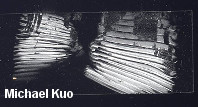
Spore print
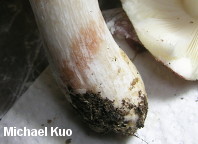
Iron salts
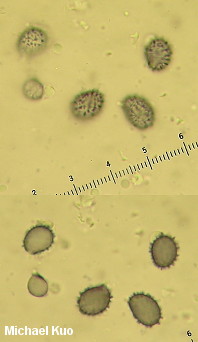
Spores (fine focus rolled to show ornamentation height)
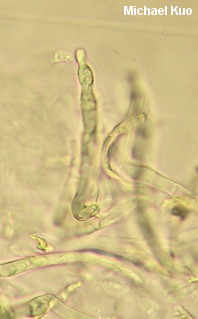
Pileocystidia
© MushroomExpert.Com
